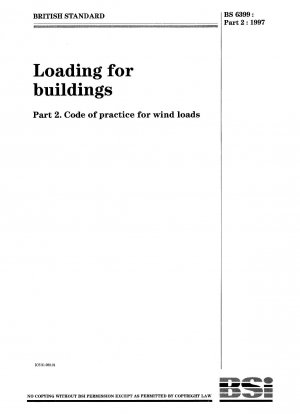BS 6399-2:1997
Loading for buildings - Code of practice for wind loads
- Standard No.
- BS 6399-2:1997
- Release Date
- 1997
- Published By
- British Standards Institution (BSI)
- Status
- 2005-04
- Replace By
- BS EN 1991-1-4:2005
- BS EN 1991-1-4:2005+A1:2010
- BS 6399-2:1997(2002)
- Latest
- BS EN 1991-1-4:2005+A1:2010
- BS 6399-2:1997(2002)
- Scope
- This Part of BS 6399 gives methods for determining the gust peak wind loads on buildings and components thereof that should be taken into account in design using equivalent static procedures. Two alternative methods are given: a) a standard method which uses a simplified procedure to obtain a standard effective wind speed which is used with standard pressure coefficients to determine the wind loads for orthogonal design cases. NOTE 1. This procedure is virtually the same as in CP3 : Chapter V : Part 2. b) a directional method in which effective wind speeds and pressure coefficients are determined to derive the wind loads for each wind direction. Other methods may be used in place of the two methods given in this standard, provided that they can be shown to be equivalent. Such methods include wind tunnel tests which should be taken as equivalent only if they meet the conditions defined in annex A. NOTE 2. Wind tunnel tests are recommended when the form of the building is not covered by the data in this standard, when the form of the building can be changed in response to the test results in order to give an optimized design, or when loading data are required in more detail than is given in this standard. Specialist advice should be sought for building shapes and site locations that are not covered by this standard. The methods given in this Part of BS 6399 do not apply to buildings which, by virtue of the structural properties, e.g. mass, stiffness, natural frequency or damping, are particularly susceptible to dynamic excitation. These should be assessed using established dynamic methods or wind tunnel tests. NOTE 3. See references [1] to [4] for examples of established dynamic methods. NOTE 4. If a building is susceptible to excitation by vortex shedding or other aeroelastic instability, the maximum dynamic response may occur at wind speeds lower than the maximum.
BS 6399-2:1997 history
- 2005 BS EN 1991-1-4:2005+A1:2010 Eurocode 1. Actions on structures. General actions. Wind actions
- 2005 BS EN 1991-1-4:2005 Eurocode 1: Actions on structures. Part 1-4: General actions .Wind actions
- 1997 BS 6399-2:1997 Loading for buildings - Code of practice for wind loads
- 1995 BS 6399 Pt.2:1995 Loading for buildings. Code of practice for wind loads
